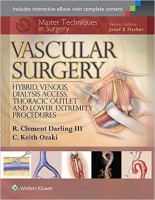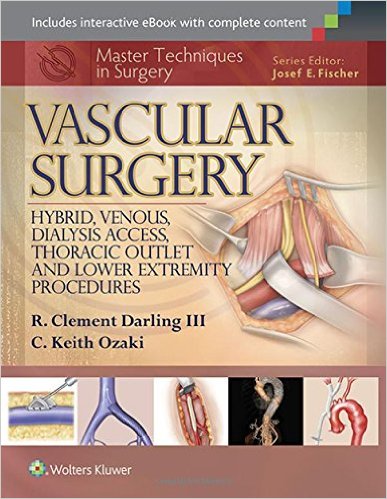 (Part of the Master Techniques in Surgery series)
(Part of the Master Techniques in Surgery series)
Editors: R. Clement Darling III, MD; and C. Keith Ozaki, MD
Publisher: Wolters Kluwer | Lippincott, Williams & Wilkins – 297 pages
Book Review by: Nano Khilnani
The editors of this book – Drs. R. Clement Darling and C. Keith Ozaki – point out that good vascular surgeons possess a unique set of skills. They have the ability to:
- Perform and interpret diagnostic imaging
- Be involved in vascular patients’ medical management
- Do therapeutic interventions and open reconstructive surgery
Essentially these skills are not so easy to learn for medical students, residents and fellows, much less master them. They are very challenging tasks to perform and become competent with, the editors write in their Preface.
This outstanding procedure-based textbook has been painstakingly developed to assist trainees and aspiring vascular surgeons read and see how the various operations are done. It is also for established practitioners, so they can discover additional surgical procedures that they may not yet be familiar with, or still not be very good at.
The goal of the editors is for this book is “to provide a succinct diagrammatic approach to all common (as well as some less common) endovascular, and open procedures that one could briefly review the steps as outlined by true practicing experts. Ideally, this will provide the surgeon a road map to a variety of contemporary vascular interventions.”
Towards this goal, the editors enlisted the expertise of 53 physicians and surgeons, many of them specialists in vascular and endovascular surgery, to write the 30 chapters of this book, which are organized around five Parts that we list below for you as an overview:
- Hybrid Procedures
- Venous Procedures
- Dialysis Access Procedures
- Thoracic Outlet Procedures
- Lower Extremity Amputation Procedures: Foot to Hip
The entire contents of the print edition are available for download as an eBook. Follow these simple steps:
- Go to http://solution.lww.com/access
- Enter the Access Code found on the inside front cover of this book
- Enter your information, click Submit, and follow the on-screen instructions to start reading your eBook
Your book purchase includes not only a complimentary download of the enhanced eBook for iOS, Android, PC and Mac, but also these features:
- Complete content with enhanced navigation
- Powerful search tools and smart navigation cross-links that pull results from content in the book, your notes, and even the web
- Cross-linked pages, references, and more for easy navigation
- Highlighting tool for easier reference of key content throughout the text
- Ability to take and share notes with friends and colleagues
- Quick reference tabbing to save your favorite content for future use
As you browse through this book, you will find some common organizational elements within its chapters. A typical chapter outline includes:
- Introduction
- Indications
- Contraindications
- Preoperative Planning
- Surgery (Positioning, Technique)
- Postoperative Management
- Complications
- Results
- Conclusions
- Recommended References and Readings
The systematic organization of content in each chapter, with discussions, outlines of surgical steps, and presentation of superb full-color, fine-line illustrations, enables you to study each problem (or condition, disease, disorder, or injury) in the same manner as other problems in other chapters. As you learn to do simpler surgical procedures, you acquire the basic skills, and your self-confidence grows.
When you next begin to do a procedure that is a little more involved, you gain additional knowledge and experience, and acquire more skills. And as you do the same or similar surgical procedures more often, your hands become more skillful, and your fear and hesitation diminishes.
Let us take a look at the contents of chapter 3, Combined Iliac Stent with Femoral Endarterectomy by Richard J. Powell, MD, to get an idea of what you will find in other chapters as well.
One of the surgical procedures used to deal with occlusive disease in the common femoral artery (CFA) in the leg is endarterectomy, with patch angioplasty.
An endarterectomy is basically a procedure that removes diseased material from inside an artery. It also takes out any occluding deposits, with the aim being to leave a smooth lining within the vessel, so the blood can flow normally. Patch angioplasty is a procedure to sew up the incision made to insert the stent that will enable smooth blood flow,
“The management of disease that extends proximally into the external iliac arteries (EIA) is a more challenging problem,” Dr. Powell points out. He informs us that per guidelines of the Trans-Atlantic Society Consensus (TASC II), external iliac disease is classified as either TASC C or D depending on the extent of iliac involvement.
In the Indications and Contraindications portion of this chapter, Dr. Powell writes that there are three reasons why this procedure should be used:
- Disabling claudication
- Critical limb ischemia
- An inflow adjunct to femoral-femoral or infrainguinal bypass grafting
In the Preoperative Planning section, he states: “All patients undergo preoperative peripheral vascular evaluation with physical examination, ankle-brachial indices (ABI), and either duplex ultrasound, computed tomography angiography (CTA) or digital subtraction angiography (DSA) to assess iliac or CFA burden.”
In the Positioning subsection of the Surgery section of this chapter, the author instructs you that the patient be placed in a supine position on an x-ray compatible table, with the availability of high-quality fluoroscopic imaging, and intravascular ultrasound (IVUS).
In the Procedure subsection, he informs us: “Standard CFA exposure is gained usually under general anesthesia, though local anesthesia is an option in selected patients.” He then lists and discusses 13 other detailed instructions.
In Postoperative Management, the author lists and discusses three steps that include an anti-platelet therapy post procedure; discharge on the first postoperative day unless continued foot wound management is necessary; and patients are seen in the doctor’s office about one, six and 12 months after surgery “with repeat hemodynamic non-invasive studies.”
In Complications, four types are mentioned and discussed: wound infection, inadvertent coverage of the hypogastric artery, iliac rupture, and “stent failure from either restenosis due to intimal hyperplasia or failed ability to adequately dilate the vessel due to calcification.”
Finally, in the Results section, the author Dr. Richard J. Powell, who is Professor of Surgery and Radiology and Chief of the Section on Vascular Surgery at Dartmouth-Hitchcock Medical Center in Lebanon, New Hampshire, informs us:
“We have performed this procedure in over 200 patients. In all patients CFA endarterectomy was performed with patch angioplasty. In 39 percent of the cases, the EIA is the only iliac segment treated (TASC C). In 61 percent of the cases, both the EIA and the common iliac artery (CIA) were treated (TASC D). Forty-one percent of treated iliac vessels were occluded at the time of intervention.”
“In 67 percent of cases, the superficial femoral artery (SFA) and profunda were patent at the completion of the procedure. In 30 percent, only the profunda was patent, and in 3 percent, only the SFA was patent at endarterectomy completion. There were 21 (11 percent) concomitant distal bypasses, 6 (3 percent) SFA stents, and 25 (13 percent) femoral-femoral bypass grafts performed.”
In essence, if you want to see exactly how to perform every essential procedure relating to vascular surgery, whether endovascular, open, or combined, with step-by-step illustrations and instructions, this is the book to acquire !
Editors:
R. Clement Darling III, MD is Professor of Surgery at Albany Medical College; and Chief of the Division of Vascular Surgery at Albany Medical Center Hospital; and Director of the Institute for Vascular Health and Disease, and President of The Vascular Group in Albany, New York.
C. Keith Ozaki, MD is John A. Mannick Professor of Surgery at Brigham and Women’s Hospital, and at Harvard Medical School in Boston, Massachusetts.
Series Editor:
Josef E. Fischer, MD is William V. McDermott Professor of Surgery at Harvard Medical School and Chair Emeritus of the Department of Surgery at Beth Israel Deaconess Medical Center in Boston, Massachusetts.
Illustrations by:
Body Scientific International Inc.
Anne Rains, Arains Illustration, Inc.







